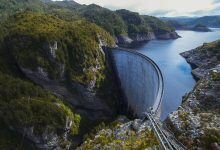The island state of Tasmania is often described as the only Australian state grid with 100 per cent renewables, thanks to its historic dependence on hydro power, but it’s been struggling to maintain that reputation in recent months.
In June, the state owned utility Hydro Tasmania fired up its Tamar Valley gas fired generators for the first time in five years, because an extended dry period was putting pressure on the state’s hydro resources.
Now, according to analysts at GPE NEMLog, the share of hydro generation in the state’s grid has fallen to a record low of 9.9 per cent, a combination of preserving the depleted hydro resources and because of maintenance at some key facilities.
The 9.9 per cent share occurred at 3.05 am on Wednesday morning, a time of day when it has often turned to imports from Victoria and its newly restarted gas power to reduce the amount of hydro being produced. At 3.30am, hydro output hit a record low of 120 MW.
At the time for the record low share, wind was providing 40 per cent of the state’s electricity demand, imports from Victoria 33 per cent, and gas 17 per cent.
The 9.9 per cent hydro share is below the previous low of 10.2 per cent in June, and 11.2 per cent in January, 2021. Back in 2019, the lowest share of hydro in the state’s grid was 27.7 per cent, according to GPE NEMLog.
Tasmania has consistently boasted the highest share of renewables in the grid. Even though it is commonly described as 100 per cent renewables, it is not always the case and annual averages have ranged from 84 per cent to 114 per cent over the last 10 years, and mostly between 93 per cent and 98 per cent renewables.
However, 2024 is shaping up as the lowest to date with a share of just 76 per cent renewables so far this year, with hydro providing just under 60 per cent, wind 14.2 per cent and rooftop solar 3 per cent.
In the first half of the year, renewables accounted for just 66.2 per cent of local demand, which put it below South Australia, which sourced 66.4 per cent of its local demand from just wind and solar – and normally averages more than 70 per cent.
South Australia has a goal of reaching 100 per cent net renewables – through wind and solar and battery storage – by 2027. Tasmania has a goal of 200 per cent renewables, primarily through local green industry and exports through its battery of the nation project.
But the recent dry spell puts some doubt on that ambition. “It is a significant milestone given the state’s reliance on hydro power as a cornerstone of its energy source for not only Tasmania but also the mainland NEM,” says Geoff Eldridge, from GPE NEMLog.
“This development is crucial for understanding Tasmania’s future as the ‘Battery of the Nation’.” But he said that integrating the new hydro and pumped storage into Tasmania’s existing hydro scheme could improve water management during droughts.
“During droughts, low dam capacities necessitate careful water management by Tas Hydro,” he said.
“The BOTN initiative, with additional hydro and pumped storage, uses excess energy from Vic and Tas solar, rooftop PV and wind to pump water to higher reservoirs. This would enable efficient energy storage, offering sustained capacity from 12 hours to two days, complementing sun and wind availability.
“By balancing diverse demand, wind resources, and hydropower storage, both Victoria and Tasmania can develop new renewable assets cost-effectively.
“This stored water can be released during peak demand, ensuring stable power supply and conserving natural river flows. This approach enhances grid stability, reduces curtailment, and provides reliable electricity during droughts, given a relatively cheap energy source for recharging.”



